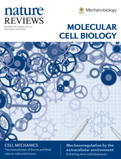| TABLE OF CONTENTS |
 |
| |
| December 2017 Volume 18 Number 12 | Advertisement
|
| 2016 2-year Impact Factor 46.602 Journal Metrics 2-year Median 28.5 | In this issue
  Comment Comment
  Research Highlights Research Highlights
  Focus on: Mechanobiology Focus on: Mechanobiology
  Reviews Reviews
  Correction Correction
|
|
| |
 |
| Advertisement |
 |
| |
 |
| |
| Advertisement |
 |
| |
 |
| |
 Comment: Mechanobiology by the numbers: a close relationship between biology and physics Comment: Mechanobiology by the numbers: a close relationship between biology and physics
Ulrich S. Schwarz
p711 | doi:10.1038/nrm.2017.109
Studies of mechanobiology lie at the interface of various scientific disciplines from biology to physics. Ulrich Schwarz discusses the importance of technological advances, quantification and modelling for the progress in understanding the role of forces in biology.
Abstract | Full Text | PDF
|
| |
 |
| Advertisement |
 |
| |
 |
 |
| |
 Focus on: Mechanobiology Focus on: Mechanobiology | | REVIEWS | Top | Regulation of genome organization and gene expression by nuclear mechanotransduction
Caroline Uhler & G. V. Shivashankar
p717 | doi:10.1038/nrm.2017.101
Mechanical cues from the microenvironment can be efficiently transmitted to the nucleus to engage in the regulation of genome organization and gene expression. Recent technological and theoretical progress sheds new light on the relationships between cell mechanics, nuclear and chromosomal architecture and gene transcription.
Abstract | Full Text | PDF
| Mechanical forces direct stem cell behaviour in development and regeneration
Kyle H. Vining & David J. Mooney
p728 | doi:10.1038/nrm.2017.108
Physical cues regulate stem cell fate and function during embryonic development and in adult tissues. The biophysical and biochemical properties of the stem cell microenvironment can be precisely manipulated using synthetic niches, which provide key insights into how mechanical stimuli regulate stem cell function and can be used to maintain and guide stem cells for regenerative therapies.
Abstract | Full Text | PDF | Supplementary information
| Mechanobiology of collective cell behaviours
Benoit Ladoux & Rene-Marc Mege
p743 | doi:10.1038/nrm.2017.98
Coordinated movements of cell collectives are important for morphogenesis, tissue regeneration and cancer cell dissemination. Recent studies, mainly using novel in vitro approaches, have provided new insights into the mechanisms governing this multicellular coordination, highlighting the key role of the mechanosensitivity of adherens junctions and mechanical cell-cell coupling in collective cell behaviours.
Abstract | Full Text | PDF | Supplementary information
| Mechanobiology of YAP and TAZ in physiology and disease
Tito Panciera, Luca Azzolin, Michelangelo Cordenonsi & Stefano Piccolo
p758 | doi:10.1038/nrm.2017.87
The transcription factors YAP and TAZ have recently emerged as being conserved transducers of mechanical signals into cells and mediators of processes such as proliferation, migration and cell fate decision. The roles of YAP-mediated and TAZ-mediated mechanotransduction have now been documented in many physiological and pathological contexts, providing novel insights into cellular mechano-responses and their consequences.
Abstract | Full Text | PDF
| Piezos thrive under pressure: mechanically activated ion channels in health and disease
Swetha E. Murthy, Adrienne E. Dubin & Ardem Patapoutian
p771 | doi:10.1038/nrm.2017.92
Soon after their discovery in 2010, Piezo channels became a paradigm for studying mechanosensitive ion channels. These channels respond to physiologically relevant forces in diverse cellular contexts, and their dysfunction has been linked to various diseases. We are now starting to understand gating mechanisms of Piezo channels and their key roles in physiology.
Abstract | Full Text | PDF
| | |
 |
| |
CORRECTION
| Top |
Publisher correction: The essential kinase ATR: ensuring faithful duplication of a challenging genome.
Joshua C. Saldivar, David Cortez & Karlene A. Cimprich
p783 | doi:10.1038/nrm.2017.116
Full Text | PDF
|
|
|
| Advertisement |
 |
| |
 |
| |
|
|
|
| Advertisement |
 |
| |
 |
| |
 |  |  |  |  |  | Natureevents is a fully searchable, multi-disciplinary database designed to maximise exposure for events organisers. The contents of the Natureevents Directory are now live. The digital version is available here.
Find the latest scientific conferences, courses, meetings and symposia on natureevents.com. For event advertising opportunities across the Nature Publishing Group portfolio please contact natureevents@nature.com |  |  |  |  |  | |











No comments:
Post a Comment